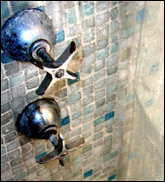Dear Umbra,
Do you have any tips on dealing with the nasty black mold that appears in bathrooms without dousing it in highly toxic chemicals?
Kirsten
Dearest Kirsten,
I read that hydrogen peroxide would work, so I tried it for you in the Grist Test Bathroom. The recommendation was to dilute the solution in a spray bottle, spritz the mold, then return a few hours later to wipe it away. It didn’t work. But my control mold is deeply embedded within the grout and caulking. Perhaps if I had acted earlier, when the mold first arrived, I would have had more success.

Grout, grout, let it all out.
Photo: Tim & Annette Gulick.
Another suggestion I’ve seen is to use Borax. I’ll try it right now. Hold on. Nope, that didn’t work either. (Another issue with my control mold is that I decided after my failed hydrogen peroxide attempt that it had permanently fused with the caulk and that said caulk therefore needed to be torn out. Hence I don’t have much of a mold sample to work with today.)
I suspect that the real answer to your question is this: Avoiding the mold, and avoiding having to resort to highly toxic responses to the mold, will best be achieved by regularly cleaning your bathroom with a basic vinegar/baking-soda/hot-water cocktail. Isn’t that just so typical of environmentally conscious solutions? They often center on planning ahead and acting before a problem arises, and, frankly, that’s a pain in the neck. Want to bike instead of driving? Have to leave more time. How about carpooling? Have to arrange in advance. Don’t want to use pesticides in the garden? Get plants that will thrive in your area in the first place. Don’t want mold? Clean the bathroom. I get tired just thinking about it.
I’ll keep working on this for you. I’ll replace the caulk and try very hard to wash with vinegar and soap on a regular basis. If that doesn’t work, I’m going to paint the bathroom black.
Innovatively,
Umbra

